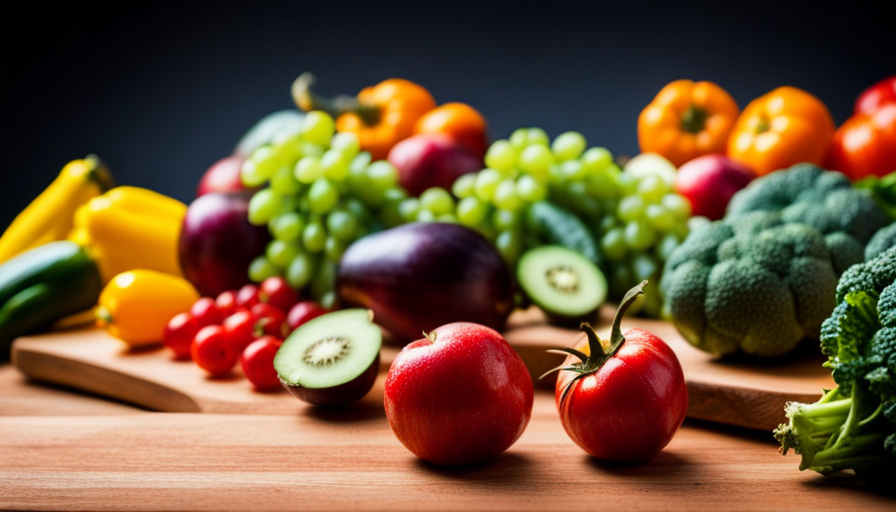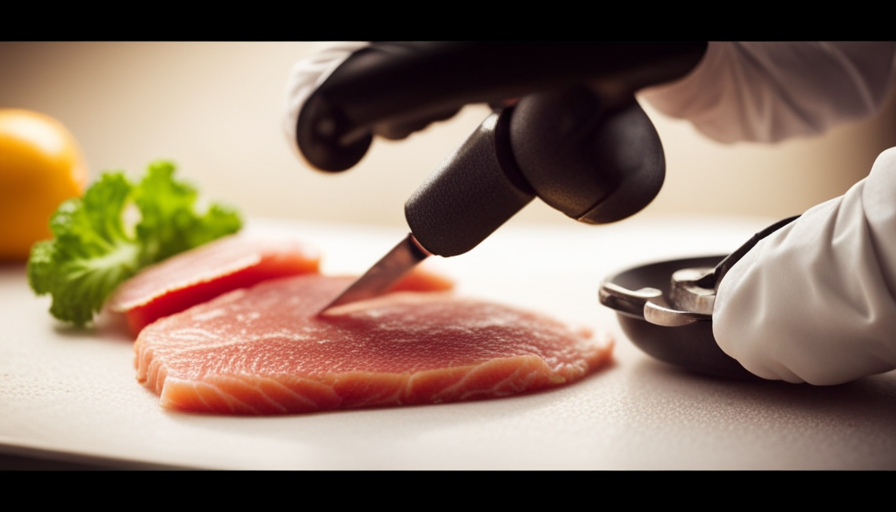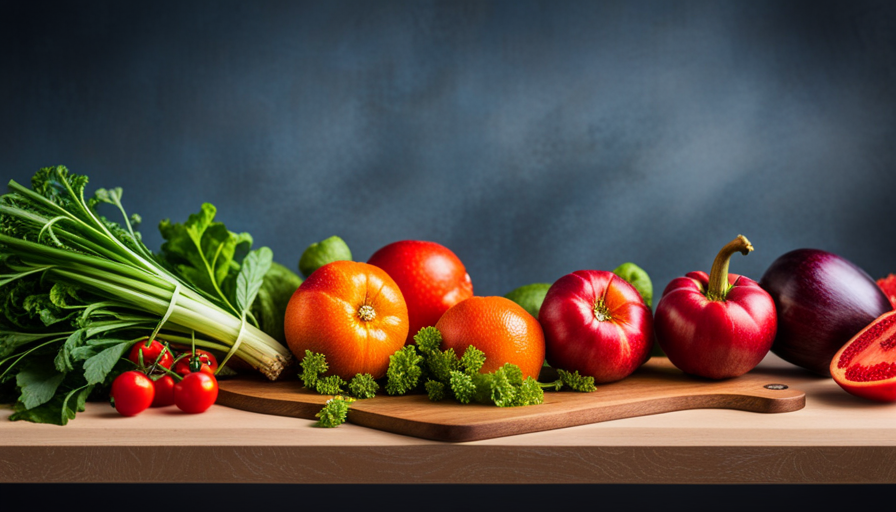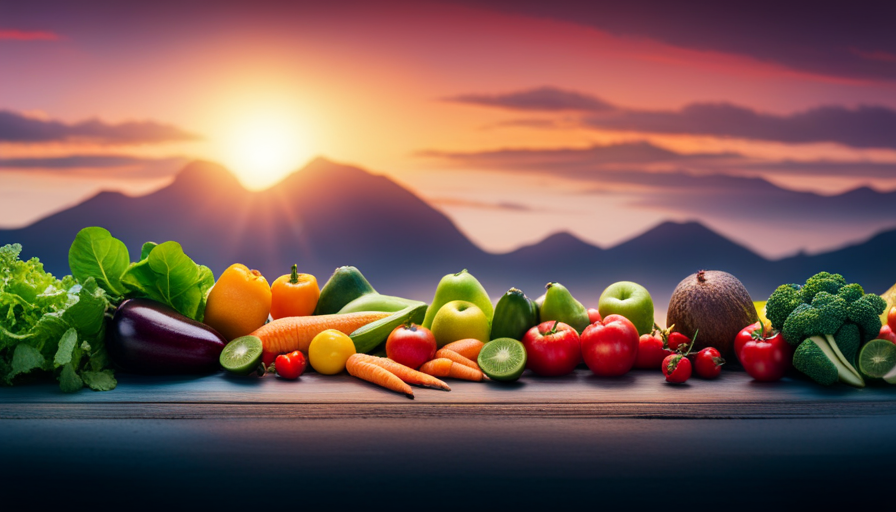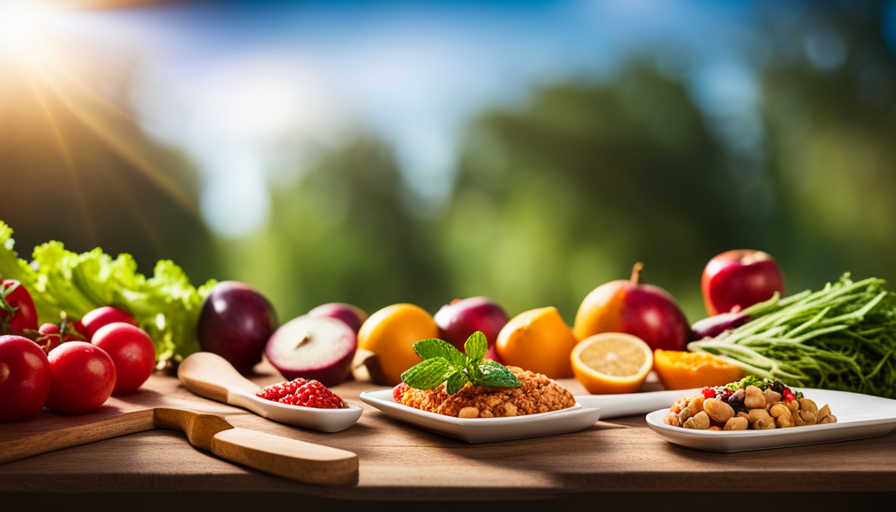Hello, fellow health enthusiasts! Are you prepared to explore the realm of raw food diets? Get ready for an exciting journey focused on counting calories like never before.
Picture this: you wake up feeling energized, knowing that every bite you take is fueling your body with pure, unprocessed goodness. That’s the beauty of a raw food diet – it’s all about consuming foods in their most natural state, without any cooking or heating involved.
But here’s the burning question on everyone’s mind: how many calories should you be consuming on a raw food diet?
In this article, we’ll delve into the nitty-gritty of determining your daily caloric needs, monitoring portion sizes, and finding the perfect balance of macronutrients.
We’ll also explore nutrient-dense raw food options, how to listen to your body’s hunger and fullness cues, and the importance of staying hydrated.
Plus, we’ll discuss how to adjust your caloric intake for weight loss or gain.
So, whether you’re a seasoned raw foodie or just starting your journey, get ready to discover the ins and outs of calorie counting on a raw food diet. Let’s dig in!
Key Takeaways
- Daily caloric needs should be calculated based on age, gender, weight, and activity level.
- Portion control is important in a raw food diet due to lower calorie density.
- Food diaries or calorie-tracking apps can help monitor nutritional intake.
- Balancing macronutrients is important in a raw food diet.
Understanding the Raw Food Diet
Are you ready to transform your health and nourish your body with the raw food diet?
The raw food diet is a way of eating that involves consuming mostly uncooked and unprocessed foods, such as fruits, vegetables, nuts, and seeds. By following this diet, you can provide your body with essential nutrients and enzymes that are often lost during cooking.
When it comes to meal planning and prepping on a raw food diet, it’s important to focus on variety and balance. You can create delicious and nutritious meals by incorporating a wide range of fruits, vegetables, and plant-based proteins.
It’s also important to calculate your daily caloric needs to ensure you’re getting enough energy from your raw food diet. This can be done by considering factors such as your age, gender, weight, and activity level. By understanding and calculating your caloric needs, you can ensure that you’re providing your body with the right amount of fuel it needs to thrive on a raw food diet.
Calculating Your Daily Caloric Needs
To determine how much energy your body requires each day, you should first calculate your daily caloric needs on a raw food lifestyle. This involves understanding the number of calories your body needs to maintain its current weight and activity level. There are various methods to calculate your daily caloric needs, but one commonly used formula is the Harris-Benedict equation. This equation takes into account your gender, age, weight, and activity level to estimate your basal metabolic rate (BMR), which is the number of calories your body needs to function at rest. From there, you can add calories based on your activity level to get an estimate of your total daily energy expenditure (TDEE).
To make it easier for you to track your nutritional intake, you can use a food diary or a mobile app that allows you to input the foods you eat and calculates the calories for you. It’s important to note that these calculations are just estimates and individual needs may vary. It’s always a good idea to consult with a registered dietitian or nutritionist to get personalized guidance.
Now that you know how to calculate your daily caloric needs, the next step is to monitor portion sizes to ensure you’re consuming the right amount of calories for your goals.
Monitoring Portion Sizes
Keeping track of portion sizes is a piece of cake, said no one ever. But when it comes to maintaining a raw food diet, portion control becomes essential. Tracking calorie intake becomes even more crucial because raw food diets tend to be lower in calories compared to cooked food diets.
Raw fruits, vegetables, nuts, and seeds are all nutrient-dense but tend to be less calorie-dense. This means that you may need to consume larger quantities of raw food to meet your daily caloric needs.
To monitor portion sizes effectively, it’s helpful to invest in a food scale and measuring cups. This allows for accurate measurements and ensures that you’re not consuming excess calories. Additionally, keeping a food diary or using a calorie-tracking app can help you stay accountable and aware of your calorie intake.
It’s important to remember that portion control is not about restricting yourself but rather finding the right balance to meet your nutritional needs.
Balancing macronutrients on a raw food diet is the next step to consider. By including a variety of fruits, vegetables, nuts, and seeds in your diet, you can ensure that you’re getting a good mix of carbohydrates, proteins, and fats.
Balancing Macronutrients on a Raw Food Diet
When following a raw food diet, it’s important to ensure that you’re getting enough protein to support your body’s needs. Incorporating healthy fats is also crucial for providing energy and supporting various bodily functions. Choosing the right carbohydrates is another key aspect to consider, as they provide essential nutrients and fiber.
By balancing these macronutrients, you can thrive on a raw food diet and maintain optimal health.
Getting Enough Protein
Eating a raw food diet can still provide you with enough protein to support your active lifestyle and keep you feeling satisfied. While it may seem challenging to meet your protein requirements on a raw food diet, there are plenty of protein sources available.
Nuts and seeds, such as almonds, hemp seeds, and chia seeds, are excellent sources of plant-based protein. Additionally, leafy greens, spirulina, and sprouts also contain protein. It’s important to incorporate a variety of these protein sources into your meals to ensure you’re getting all the essential amino acids your body needs.
If you’re concerned about getting enough protein, you can also consider incorporating plant-based protein powders into your diet.
Transitioning to the next section about incorporating healthy fats, it’s essential to also focus on incorporating sources of healthy fats into your raw food diet.
Incorporating Healthy Fats
Incorporating healthy fats into your raw food lifestyle is like adding a luxurious touch of avocado to your already exquisite culinary masterpiece. Healthy fat sources such as avocados, nuts, and seeds provide numerous benefits when included in a raw food diet. These fats not only add flavor and richness to your meals, but they also contribute to overall health and well-being. They are essential for proper brain function, hormone production, and the absorption of fat-soluble vitamins. Additionally, healthy fats help to keep you feeling satisfied and full, reducing the temptation to indulge in unhealthy snacks. To help you incorporate these fats into your raw food lifestyle, here is a table showcasing some common healthy fat sources:
| Healthy Fat Sources | Benefits |
|---|---|
| Avocado | Rich in monounsaturated fats, vitamins, and minerals |
| Nuts and Seeds | Provide protein, fiber, and essential fatty acids |
| Coconut | Contains medium-chain triglycerides, beneficial for energy |
| Olives | Packed with antioxidants and heart-healthy monounsaturated fats |
| Flaxseed | High in omega-3 fatty acids, great for heart health |
By incorporating these healthy fats into your raw food diet, you can enhance both the taste and nutritional value of your meals. Now, let’s move on to the next step – choosing the right carbohydrates.
Choosing the Right Carbohydrates
To truly savor the delights of your raw food lifestyle, it’s essential to choose the right carbohydrates for a satisfying and nourishing experience. When it comes to choosing healthy fats, it’s important to understand macronutrients and their role in our diet.
Here are three key factors to consider when selecting the right carbohydrates:
-
Fiber content: Opt for carbohydrates that are high in fiber, such as leafy greens, cruciferous vegetables, and berries. These not only provide essential nutrients but also help maintain a healthy digestive system.
-
Glycemic index: Choose low glycemic index carbohydrates like sweet potatoes, quinoa, and legumes. These slow-release carbohydrates prevent spikes in blood sugar levels and provide sustained energy throughout the day.
-
Variety: Incorporate a wide range of carbohydrate sources to ensure you receive a diverse array of nutrients. Include whole grains, fruits, and vegetables in your diet to maximize your nutritional intake.
By understanding the importance of choosing the right carbohydrates, you can create a well-rounded and nutrient-dense raw food diet. Transitioning into the subsequent section about nutrient-dense raw food options, we can explore further ways to enhance our raw food experience.
Nutrient-dense Raw Food Options
When it comes to a nutrient-dense raw food diet, there are several key points to consider.
First, high-protein plant foods such as legumes, nuts, and seeds are essential for providing the body with the necessary building blocks for muscle growth and repair.
Second, healthy fat sources, such as avocados and coconut oil, are important for promoting brain health and supporting hormone function.
Lastly, fiber-rich carbohydrate sources, like fruits and vegetables, not only provide energy but also help to regulate digestion and maintain stable blood sugar levels.
By incorporating these nutrient-dense options into a raw food diet, one can ensure they’re meeting their nutritional needs while enjoying a variety of delicious and satisfying foods.
High-Protein Plant Foods
Consuming high-protein plant foods on a raw food diet is like fueling your body with the ultimate power source. Not only do these foods provide the necessary building blocks for muscle growth and repair, but they also offer a wide range of health benefits. Plant-based protein is not only rich in essential amino acids, but it is also packed with vitamins, minerals, and antioxidants. To give you an idea of the protein content in some popular plant foods, take a look at the table below:
| Plant Food | Protein Content (per 100g) |
|---|---|
| Quinoa | 14g |
| Lentils | 9g |
| Chickpeas | 9g |
| Hemp Seeds | 31g |
| Spirulina | 57g |
By incorporating these high-protein plant foods into your raw food diet, you can ensure that your body receives the necessary nutrients to thrive. Now let’s move on to discussing healthy fat sources.
Healthy Fat Sources
After discussing high-protein plant foods, let’s now move on to the importance of healthy fat sources in a raw food diet.
While many people may associate a raw food diet with being low in fat, it’s crucial to include healthy fats for optimal health.
Healthy fat sources in a raw food diet can include avocados, nuts, seeds, and coconut oil. These healthy fats provide essential nutrients and benefits such as improved brain function, hormone production, and heart health.
Incorporating these fats into your diet can also help you feel more satisfied and satiated, preventing unnecessary snacking or overeating.
It’s important to remember that moderation is key when consuming healthy fats, as they’re still calorie-dense.
Now, let’s dive into the next section about fiber-rich carbohydrate sources.
Fiber-Rich Carbohydrate Sources
Incorporating fiber-rich carbohydrate sources into your daily meals can provide you with the necessary nutrients for optimal health and digestion. Here are four nutrient-dense raw food options that are packed with fiber:
-
Chia seeds: These tiny seeds are high in fiber and can absorb up to 10 times their weight in water, helping you feel full and satisfied.
-
Sweet potatoes: Not only are they delicious, but sweet potatoes are also a great source of complex carbohydrates and fiber, promoting a healthy gut.
-
Quinoa: This gluten-free grain is not only high in fiber but also contains all nine essential amino acids, making it a complete protein.
-
Berries: Loaded with antioxidants and fiber, berries are a tasty way to add some sweetness to your raw food diet.
By incorporating these fiber-rich carbohydrate sources into your meals, you can ensure that you’re getting the necessary nutrients while enjoying a variety of delicious options.
Now, let’s dive into the next section about meal planning and prepping.
Meal Planning and Prepping
When it comes to meal planning and prepping on a raw food diet, there are a few key points to keep in mind. First, it’s important to create balanced meals that include a variety of nutrient-dense foods.
This can be achieved by incorporating a range of fruits, vegetables, nuts, and seeds. Additionally, it’s beneficial to consider seasonal produce to ensure optimal freshness and flavor.
Lastly, batch cooking and proper food storage can help save time and ensure that you always have healthy options on hand.
Creating Balanced Meals
To create balanced meals on a raw food diet, it’s important to carefully select a variety of nutrient-rich fruits, vegetables, nuts, and seeds. These ingredients provide essential vitamins, minerals, and antioxidants that support overall health and well-being.
When planning your meals, consider incorporating the following:
- Leafy greens: Spinach, kale, and Swiss chard are packed with vitamins A, C, and K.
- Colorful fruits: Berries, oranges, and watermelon offer a wide range of antioxidants and fiber.
- Protein sources: Include almonds, hemp seeds, and chia seeds to ensure adequate protein intake.
- Healthy fats: Avocado, flaxseed, and walnuts provide omega-3 fatty acids for brain health.
By incorporating these nutrient-dense recipes into your meal planning, you can ensure a well-rounded and satisfying raw food diet. Additionally, it’s important to incorporate variety and seasonal produce to keep your meals exciting and maximize nutritional benefits.
Incorporating Variety and Seasonal Produce
Try exploring different fruits and vegetables that are in season to add variety to your meals, even if you think it might be challenging to find them at your local grocery store.
Incorporating a variety of produce not only adds different flavors and textures to your meals, but also ensures that you’re getting a wide range of nutrients. You can experiment with different recipes that incorporate seasonal produce, such as salads with fresh berries in the summer or roasted root vegetables in the winter.
Not only will this keep your meals interesting, but it’ll also support local farmers and reduce your carbon footprint. In addition, seasonal produce is often more affordable and tastes better since it’s harvested at its peak ripeness.
As you explore different fruits and vegetables, you’ll discover new favorites and enjoy the benefits of a diverse and nutritious raw food diet.
Now, let’s move on to the next section about batch cooking and food storage tips.
Batch Cooking and Food Storage Tips
You can save time and effort in the kitchen by batch cooking and using effective food storage techniques. For example, imagine coming home after a long day and having a delicious and nutritious homemade soup ready to heat up and enjoy for dinner.
Here are three batch cooking tips and food storage suggestions to help you make the most of your raw food diet:
-
Plan your meals and ingredients ahead of time to ensure you have everything you need for batch cooking.
-
Invest in quality food storage containers that are airtight and BPA-free to keep your prepared meals fresh for longer.
-
Label and date your stored foods to easily identify what needs to be consumed first.
By implementing these batch cooking and food storage strategies, you can simplify your raw food diet and have healthy meals readily available. Now, let’s explore how listening to your body’s hunger and fullness cues can further enhance your dietary experience.
Listening to Your Body’s Hunger and Fullness Cues
Pay attention to your body’s hunger and fullness cues, as they’re the key to successfully maintaining a raw food diet and achieving your desired calorie intake.
When following a raw food diet, it’s important to listen to your body and eat when you’re truly hungry. This means being aware of physical signs like a growling stomach or a slight drop in energy levels. Ignoring these cues can lead to overeating or not consuming enough calories, both of which can be detrimental to your overall health and well-being.
Likewise, paying attention to your body’s signals of fullness is crucial. Raw foods tend to be less calorie-dense, so it’s important to eat until you feel satisfied, not overly full. This allows your body to digest the food properly and prevents discomfort. It’s important to note that everyone’s hunger and fullness cues may vary, so it’s essential to listen to your own body rather than comparing yourself to others.
Incorporating a variety of nutrient-dense raw foods in your diet can help ensure you meet your calorie needs while providing essential vitamins and minerals. By focusing on foods that are naturally filling, such as fruits, vegetables, and whole grains, you can maintain a healthy balance and achieve your desired calorie intake.
Transitioning into the next section about staying hydrated on a raw food diet, it’s important to remember that proper hydration is key to overall health and well-being.
Staying Hydrated on a Raw Food Diet
Staying hydrated is crucial when following a raw food diet. As someone who’s been on this diet for a while, I’ve learned the importance of water intake for maintaining optimal health and digestion.
In addition to drinking plenty of water, I also incorporate hydrating foods and beverages such as fresh fruits and vegetables, herbal teas, and coconut water. These help keep me hydrated throughout the day.
Importance of Water Intake
Drinking plenty of water on a raw food diet is like quenching the thirst of a blooming flower, nourishing your body from within. Hydration is crucial for overall health and well-being, and when following a raw food diet, it becomes even more important. Here are three reasons why water intake is essential on this type of diet:
-
Importance of hydration: Water plays a vital role in digestion, nutrient absorption, and elimination of waste from the body. It helps maintain proper body temperature and lubricates joints, making movement easier.
-
Benefits of drinking water: Staying hydrated promotes healthy skin, aids in weight management, and boosts energy levels. Water also helps to reduce cravings and supports optimal brain function.
-
Incorporating hydrating foods and beverages: In addition to drinking water, incorporating hydrating foods such as fruits and vegetables and beverages like herbal teas and coconut water can further enhance hydration levels.
Now, let’s explore the next section on incorporating hydrating foods and beverages into a raw food diet.
Incorporating Hydrating Foods and Beverages
To boost hydration on a raw food lifestyle, it’s like infusing your body with a refreshing waterfall by incorporating water-rich fruits, crisp vegetables, and nourishing herbal teas. These hydrating foods and beverages not only quench your thirst but also provide essential nutrients. For instance, watermelon, cucumber, and oranges have high water content and are packed with vitamins and minerals. Additionally, drinking water is crucial for maintaining optimal bodily functions, such as regulating body temperature and aiding digestion. To make hydration even more enjoyable, try incorporating hydrating smoothie recipes into your raw food diet. These delicious and nutrient-rich blends can be made with ingredients like coconut water, leafy greens, and berries. By staying properly hydrated, you support your overall health and well-being. Now, let’s explore how to adjust caloric intake for weight loss or gain.
Adjusting Caloric Intake for Weight Loss or Gain
If you’re trying to lose weight on a raw food diet, you should aim to consume fewer calories than you burn each day. Research has shown that reducing your daily caloric intake by just 500 calories can lead to a steady weight loss of about one pound per week.
However, it’s important to adjust your caloric intake based on your specific goals.
If your goal is to build muscle on a raw food diet, you may need to increase your caloric intake to provide your body with the energy it needs for muscle growth. This can be achieved by increasing your consumption of protein-rich raw foods, such as nuts, seeds, and legumes.
On the other hand, if your goal is to maintain your current weight on a raw food diet, you should aim to consume the same number of calories that you burn each day. This can be achieved by tracking your daily caloric intake and adjusting it as needed.
To ensure that you’re making the right adjustments to your caloric intake, it’s always a good idea to consult with a registered dietitian or nutritionist. They can provide personalized guidance and help you create a balanced meal plan that meets your specific needs.
Consulting with a Registered Dietitian or Nutritionist
When it comes to adjusting your caloric intake on a raw food diet, it can be helpful to consult with a registered dietitian or nutritionist. These professionals have the knowledge and expertise to help you determine the right amount of calories you should be consuming each day based on your specific goals and needs.
Consulting with a registered dietitian or nutritionist has many benefits. They can provide you with personalized guidance and support, taking into account your unique dietary restrictions, preferences, and health conditions. They can also help you navigate any challenges or concerns you may have while following a raw food diet.
Finding a professional who specializes in raw food diets can be a great asset on your journey towards better health. They can help you develop a well-balanced meal plan that meets your nutritional needs, ensuring you are getting all the essential nutrients your body requires. Additionally, they can provide you with practical tips and strategies to make the transition to a raw food diet easier and more sustainable.
Consulting with a registered dietitian or nutritionist can be highly beneficial when adjusting your caloric intake on a raw food diet. They can provide you with the guidance, support, and expertise needed to optimize your health and well-being.
Frequently Asked Questions
Can I eat cooked food on a raw food diet?
Yes, you can eat cooked food alternatives on a raw food diet. While the main focus is on consuming raw, unprocessed foods, there is some flexibility in including cooked options. This can help to add variety and ensure a balanced diet.
However, it’s important to note that cooking can reduce the nutritional value of certain foods. The benefits of a raw food diet include increased nutrient intake, improved digestion, and potential weight loss.
How can I ensure I am getting enough protein on a raw food diet?
To ensure I’m getting enough protein on a raw food diet, I rely on a variety of plant-based protein sources. Some fantastic options include nuts, seeds, legumes, and leafy greens. These raw foods aren’t just packed with protein but also offer essential vitamins, minerals, and fiber.
By incorporating a diverse range of these raw food protein sources into my diet, I can confidently meet my protein needs while enjoying the benefits of a raw food lifestyle.
Is it necessary to take supplements on a raw food diet?
On a raw food diet, it’s not necessarily ‘necessary’ to take supplements. However, it’s important to be mindful of potential nutrient deficiencies. Raw food diets may lack key nutrients like vitamin B12, iron, omega-3 fatty acids, and calcium. Therefore, it’s advisable to consider supplements or fortified foods to ensure adequate intake of these nutrients.
Consulting with a healthcare professional or registered dietitian can help determine if supplements are needed for optimal health on a raw food diet.
Can I still enjoy snacks and desserts on a raw food diet?
Oh, let me tell you about the delicious snacks and desserts you can enjoy on a raw food diet!
Raw food diet snacks can include things like fresh fruit, vegetable sticks with homemade dips, and raw nuts and seeds.
For dessert, you can indulge in raw chocolate mousse made from avocado and cacao powder, or a refreshing fruit sorbet.
These treats not only satisfy your sweet tooth but also provide essential nutrients and enzymes for a healthy lifestyle.
What are the potential risks or side effects of following a raw food diet?
Potential risks and side effects of following a raw food diet may include nutrient deficiencies, especially in vitamin B12, iron, calcium, and omega-3 fatty acids.
Raw foods can be harder to digest, leading to bloating, gas, and digestive discomfort.
There is also a risk of foodborne illnesses from consuming raw or undercooked foods.
It’s important to ensure a balanced and varied diet to meet nutritional needs and consult a healthcare professional before starting any new diet.
What is the Recommended Daily Caloric Intake for a Raw Food Diet?
The recommended daily caloric intake for a raw food diet varies depending on factors like age, gender, and activity level. Raw food diets are typically lower in calories compared to processed foods, so it’s important to ensure you’re getting enough calories in raw food to meet your energy needs.
Conclusion
In conclusion, the raw food diet can be a nutritious and satisfying way to fuel your body. By understanding your daily caloric needs and monitoring portion sizes, you can ensure you’re getting enough energy from this diet.
It’s important to balance macronutrients and choose nutrient-dense options to meet your nutritional requirements. One interesting statistic to note is that raw food diets have been found to increase antioxidant levels in the body by up to 30%, which can help protect against oxidative stress.
Remember to listen to your body’s cues and consult with a registered dietitian or nutritionist for personalized guidance.

